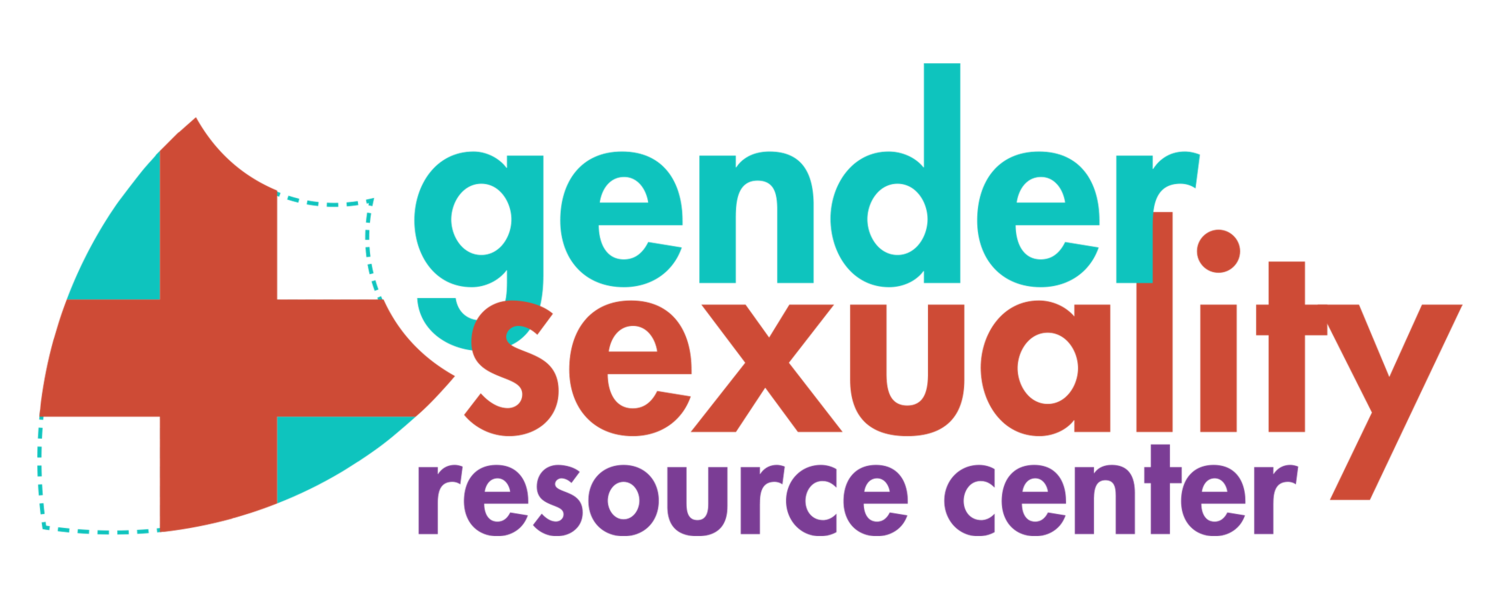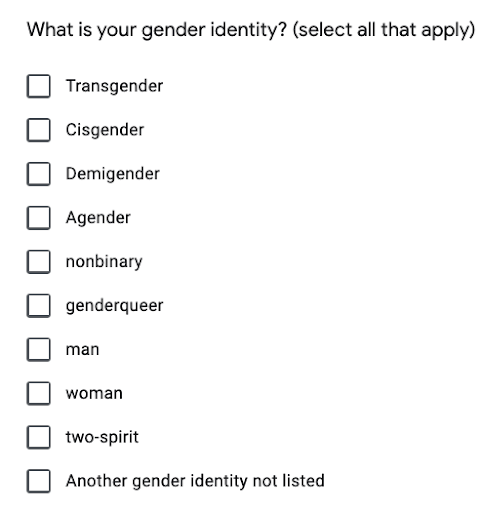Creating Inclusive Forms
When we are gathering data, whether for our department, group, or other ways – thinking about inclusion of queer identities is an essential part of that collection.
We encourage you to engage with the “pronoun” and “gender, sex, and sexuality” portions of these trainings prior to give context and understanding of the terms being used.
As Sabrina Fonseca says in their primer on UXdesigns on “Designing forms for gender diversity and inclusion” , there are some important things to consider before going into this process –
1. Give people a really good reason for asking
Are you monitoring diversity? Creating policies that will benefit them and other trans and GNC folks? Figuring out if they are eligible for benefits? Or is it for marketing and communication purposes? Is it for their doctor, or for their health insurance? Be transparent, explain what exactly you are asking about, and how it will benefit them. Reassure that your organization strives to be inclusive of everyone so they can feel welcome and protected while disclosing their information. As with any form field, if there isn’t a clear benefit to the user, you probably shouldn’t ask about it.
2. Make it private, safe, and anonymous
Let users know that information will not be shared with anyone, or allow users to manually control who sees it. Be mindful of who will see any identifying information. Check the privacy policy for your website or service for more information. Anonymize the data as much as you can, to make sure you don’t out them by accident. For example, if the results of a small survey show there’s a trans woman in the tech department, and there’s only one woman there, she has been outed
3. Always make it optional
Make that field optional as much as you can. This is part of the previous recommendation — the user may know better than you if it’s safe or appropriate to disclose the information based on the context. It may even warm them up to answer the question accurately rather than skipping it.
In 2021, Director of the GSRC Kristopher Oliviera builds on this last point – stating:
“Is there space to add make it optional, and come up with a strategy to allow folks to update their information. Because these concepts are fluid and sometimes change, we should offer dynamic processes for people to update their information as they need to.”
(Please check out the rest of the primer here)
Creating inclusive forms will not only give you a more accurate understanding of the populations that you are serving, but will let participants know that your organization has thought about their identity in more ways than others.
Please remember throughout this that the most inclusive way to create forms is to allow participants to fill out their own. This decenters “normative” identities and gives the most space for people to define their identity on their own terms.
*Please note! When you are collecting this data – make sure that it is communicating with the other systems in your workplace or within the reasons you are collecting the data. i.e. if you have someone define their gender and pronouns but automatic mailers are sent out using different information – this can be harmful and very much feel like gaslighting to the participants who just shared this information with you.
It is also important to have a clear system on how to clearly lay out a process to change these documents. If it is hard to navigate how to change name, pronouns, and other identifiers you make it more difficult for trans/nonbinary/queer people to navigate your resources.
Before we get started: It is important to answer the question “why am I collecting this data” or “do I need this information” – especially when it comes to asking for sex data and legal name. It is also important to ask should this question be required. Doing a thoughtful analysis first will help you best design the right form.
Name: Be clear on the question; make sure you state you are asking by the name that they go by and would like to be referred as. If you are asking for legal name, try to be clear on why – and if that is required make sure you are giving space for participants to state the name they go by.
Honorifics: Make sure you include gender inclusive honorifics, like Mx. (pronounced Mix) and space for participants to define their own.
Pronouns: There is a great guide on gender inclusive forms created by keshetonline and they state –
Pronouns are the words used to describe a person in the third person, so are often helpful to collect when asking other demographic information. (You can read more about why pronouns are important in Keshet’s pronoun resource.) You can ask pronouns by providing checkboxes with multiple options, as well as a write-in option.
You can also include a line explaining what pronouns are and why you are asking for this information. For example: “Please share your pronouns. Pronouns are the part of speech used to refer to someone in the third person. We want to know how to respectfully refer to you!”
Gender and/or sex:
Please refer to the “gender, sex, and sexuality” guide to make sure you have a good grasp on these terms before continuing.
When asking about sex it is crucial to ask yourself why. In doctor’s offices and certain legal documents, they also may specify to state “assigned sex at birth” – remember that this question should be accompanied by gender identity question. You should also be direct in why you are asking this question. Remember sex is not immutable, so to ask ASAB (“assigned sex at birth”) should be for a very particular reason.
Sex is, as discussed, not binary, so allowing for participants to fill in their own is still the best route. Make sure you are giving options for intersex people to identify as well.
Gender and Gender Identity are ever expanding as well. If possible, the recommendation is to allow people to fill in their response. Even if you have to aggregate the data later, you can do that with the information given. It may also be helpful for you to give an interact button that links to a website explaining what is meant by gender identity.
If you have to ask with given or preselected options, it is important that you give the options to select more than one – for example:
This allows for participants to engage with all of the ways that they may identify. It is important to understand that just allowing one of these selections may not fully encapsulate how someone identifies.
To see more examples or to see how your forms or intakes look in comparison, here is a really helpful guide designed by Ruth Ng!
Sexuality:
To ask about sexuality; again, start with analyzing why and how will you hold this information – allow space for filling this in will be important because you can get answers like “I am not sure” “I don’t know” “I am questioning” and others that allow participants to speak to where they are in this current moment. There are so many ways, much like gender, for people to identify the complex nature of sexual orientation. Be mindful of this process and make sure you are clear with your intentions.
Exercise: Look at the forms you have seen or have created – how were they made? How inclusive were they? What are ways that the can improve?
Need help or a critical eye to look at a form for you? Email the GSRC - gsrc@princeton.edu with your inquiries.


